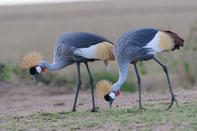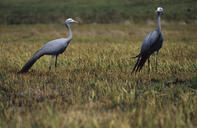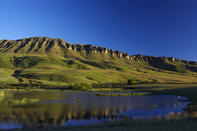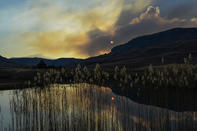Incredibly Rich Biodiversity
Soaring basaltic buttresses, rolling high-altitude grasslands, steep-sided river valleys, rocky gorges and clear mountain streams descending towards the lush green valleys opening onto the Midlands ensure that Kamberg Nature Reserve holds the position of a firm fly-fishing, hiking, trail-running and mountain-biking heaven and, to top it off, it also boasts some of the finest rock art in South Africa.
The reserve’s natural beauty is rivalled by its incredibly rich biodiversity, including many endemic species, incredible views, vast open spaces and an overwhelming sense of peace and tranquillity. Kamberg is the perfect ‘get-away-from-it-all’ destination, but be warned, the weather changes constantly and the Drakensberg forms a dramatic backdrop to the ‘out-of-the-blue’ thunderstorms, particularly in summer in the late afternoon, a truly awe-inspiring experience.
Go Birding

Kamberg Nature Reserve’s elevation is relatively low in comparison with the other Drakensberg reserves and it is for this reason that it is best known for its birdlife, with over 200 species recorded here. Look out for the Broad-tailed warbler, Cape grassbird, Drakensberg prinia, Fairy flycatcher, Red-winged francolin, Blue crane, Yellow-breasted pipit, Sickle-winged chat, Bush blackcap, Drakensberg rockjumper, Layard’s tit-babbler and Drakensberg siskin.
All three of South Africa’s cranes are threatened with extinction – they are among the country’s most spectacular birds and most easily spotted in wetlands, although the Wattled crane is a lucky find as it is critically endangered. The beautiful Blue crane is South Africa’s national bird, and calls the Kamberg Nature Reserve home. The Grey crowned crane is probably the flashiest of the three with its unmistakable prominent crest.
The Hlatikulu Crane and Wetland Sanctuary

The Hlatikulu Crane & Wetland Sanctuary near Giant’s Castle is a rescue, rehabilitation and captive breeding facility. From the 15 species of cranes found around the world, South Africa is home to three - Blue crane, Wattled crane and Grey crowned crane - all critically endangered.
The Hlatikulu Vlei is home to the cranes, and forms an important part of the Southern KwaZulu-Natal Bird Route, as it houses over 80 species of birds. Cranes are linked closely to the grassland biomes and wetlands, which is a threatened biome due to agricultural developments and human activities. This, in turn, makes the cranes that live in the biome an endangered species.
Wattled cranes are dependent on quality wetlands to breed, and most are found in the KwaZulu-Natal highlands. However, scientists have found that around 80% of the KZN wetlands have been deteriorated, which means the Wattled crane’s habitat is slowly fading away. The Hlatikulu Sanctuary is part of the Wattled Crane Recovery Programme, co-ordinated by the Johannesburg Zoo. When cranes mate and lay an egg, a second one can be laid a few days later. As soon as the first egg hatches, the parents leave the nest, effectively abandoning the second egg. That egg is then collected by field workers, and it is incubated in Pietermaritzburg. It is then flown to Johannesburg Zoo where they are raised.

